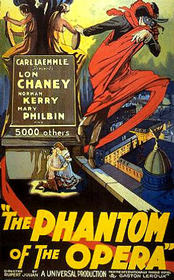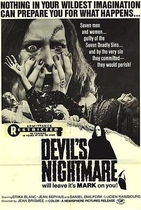Our editor-in-chief Nate Yapp is proud to have contributed to the new book Hidden Horror: A Celebration of 101 Underrated and Overlooked Fright Flicks, edited by Aaron Christensen. Another contributors include Anthony Timpone, B.J. Colangelo, Dave Alexander, Classic-Horror.com's own Robert C. Ring and John W. Bowen. Pick up a copy today from Amazon.com!
The Phantom of the Opera (1925)
"You're standing in the wings,
There you wait for the curtain to fall.
Knowing the terror and holding
You have on us all."
Those are the lyrics from the heavy metal giant Iron Maiden's timeless classic "Phantom of the Opera" released in 1980. They were my first introduction to this timeless ghoul, and the "holding" this phantom has had on me has lasted ever since. But clearly I am not alone.
A testament to any great work of art is its pervasiveness in popular culture, and one of the greatest examples of such testaments are to Phantom of the Opera (1925). At least five film remakes have been made since the original in 1925. The most recent one, released in 2004 and directed by Joel Schumacher, is an adaptation of Andrew Lloyd Weber's ridiculously successful Broadway musical. Of course the original source, Gaston Leroux's 1910 novel, first spawned this legendary ghoul. Influenced by Edgar Allan Poe and Jules Verne, Leroux's writing was marked by an eclectic mix of mystery, horror, Gothic romance, fantasy, and action. He weaved all of these styles into "Phantom."
In the original film version, Lon Chaney, who was primarily working for MGM but drifted for this film to Universal, plays the phantom. He knew a gift horse when he saw one, and the success of horror/fantasy films such as The Hunchback of Notre Dame and Kaiser, The Beast of Berlin (in which The Phantom's director, Rupert Julian, acted as the villain) were fortuitous signs for Phantom's success. However, the film was almost never made. Julian prompted several rewrites of the script, and his bullish nature irked many on the set. Legend has it that Chaney was responsible for directing some scenes while Julian was autocratically storming around the set. The original ending, which found Erik dead at the foot of his organ, was rewritten to cast the phantom into the streets of Paris being chased by an angry mob, a decision designed to spice up the final actions scenes. The film cost approximately $630,000, including $50,000 in retakes. The film ultimately allowed Universal to pocket roughly $540,000 in profits, a notable sum for 1920s cinema.
The story begins in the Paris Opera House, a location built on catacombs, ancient labyrinths, and torture chambers. The property is sold and the new owners are warned of an alleged phantom, which is in infatuated with an unknown singer named Christine Daae, played by Mary Philbin. Erik, the phantom, blackmails the famous diva Carlotta through a series of letters ordering her to relinquish her role to Christine. When she does, Christine offers a startling performance, and Erik pledges his love and fidelity to her. She abandons her lover, Raul, and vows to "forget all worldly things" with the phantom. However, after a threat from the phantom is not followed, the ghoul wreaks havoc on the opera house. Chaos ensues and Erik eventually seizes Christine and entraps her in the opera house's dark catacombs. Once she learns of the phantom's identity by ripping off his mask (one of the truly legendary scenes in horror), Erik agrees to free her for one last performance. At a ballroom dance, Christine reunites with Raul and expresses her love to him. Raul plans to leave the country with her, but Erik secretly discovers these plans and abducts Christine once again. A mysterious Persian reveals himself to Ledoux of the Parisian Secret Police, and Raul and Ledoux proceed in an elaborate search for the singer through the dark hallways of the opera house's depths. Eventually, the phantom's identity is disclosed, and he meets his fate on the streets of Paris.
The beauty of Phantom is the volume of its archetypal themes. First, the story is a classic romance of unrequited love cast in a beauty vs. the beast narrative, but the lopsided nature of this love is profoundly tragic because of Erik's ghastly appearance. Christine does fall for him. She initially wants to be his "servant", is seduced by his piano playing, and both are enamored by the fact that she "brings out the good in him". Her subservience to him is almost erotic in that she completely offers herself to the ghoul. The phantom is also an archetypal ghoul, yet he also carries a Jekyll and Hyde duality because he represents both the passionate and beautiful and horrible and evil in everyone. For every loving stroke of tender feeling he conveys to Christine, he couples it with another stroke of pure menace toward another. The love triangle that forms here between Raul, Christine, and Erik has also been copied numerous times, and the literal depths Erik will travel to express his love for Christine are truly profound.
But the film is ahead of its time in so many other thematic areas. Erik is an asylum refugee cast there because of his practice of black magic and later determined to be criminally insane. He plants the seeds for all future horror figures that were perceived as insane and clinically institutionalized only to later learn that they could not be rehabilitated and perhaps never needed to be. The cruelty of the people who misunderstand the "ugly" is directly proportionate to the complexity of the banished one's character. Phantom does an excellent job of portraying a character that successfully, at least for a time, can walk the fine line between insanity and sanity. At times, Erik's passionate overtures to Christine make him seem far from horrific; in fact, he seems a character in complete control of his emotions. He garners sympathy from the most conservative of viewers.
Furthermore, the film is also a case study in the classic haunted house tale, although this house is for operas and not the traditional domesticated abode. Additionally, the film is a morality tale warning people about the dangers of excessively pursuing success. Carlotta's misguided ambitions and the new owner's drive for success ultimately initiate the phantom's tragic endgame. They foolishly don't heed the warnings. The film also boasts an excellently choreographed chase scene at the end, full of action, drama, and twists and turns.
Finally, Phantom lays the groundwork for an endearing trademark of modernist cinema: the meta-narrative or "play within the play". Throughout the film, alternative performances abound, and viewers obtain a clear sense of the power art has in these individuals' lives. Moreover, the number of literary allusions, from "Faust" to Poe's "Masque of the Red Death" to Leroux's original novel, emphasizes the importance of art redefining art. The richness of all of these themes is one of Phantom's most important legacies.
The set design is also impressive. The setting of an opera house full of props and stage structures adds a point of realism to the film that would otherwise be lost. Here, these ornaments, such as the giant demon's head, the skull-work, and the hulking lighting equipment, all seem natural and real. They also permit an elaborate sense of composition to the film that allows chiaroscuro lighting to predominate. Erik is constantly cast in shadow among these forms and figures, and this homage to German expressionism bifurcates his character into the duality that he possesses. Because it emanates from an opera house, one can only expect an eloquent and melodramatic musical score and lavish costumes to accompany Erik's passionate orchestrations. In another setting, this would seem forced. In Phantom, it seems in perfect harmony.
Chaney is clearly at his best here, especially since he appears in a mask for most of the film. His acting is profound and must be for the film to work. The de-masking scene is still one of the scariest and shocking scenes in cinematic history. Most of that horror emanates from Chaney's body language. He allegedly used putty to raise his cheekbones, although some claim he had placed disks in his mouth to raise them. But throughout the film, Chaney's physical prowess as an actor dominates. The other actors' fears are also wonderfully cast through the lens of body language and pure acting.
There is too much to write about this classic. Clearly, Phantom is one of the greatest silent films ever made. It is taut with complex themes and fabulously acted, designed, and written. Modern viewers not used to silent films will be surprised at how easy it is to watch this film. And as one of the earliest installments of the horror genre, Phantom is still one of its best. Indeed, it's one of the greatest films ever made in any genre.
The prologue of Gaston Leroux's classic text begins with these chilling words: "The Opera ghost really existed. He was not, as was long believed, a creature of the imagination of the artists, the superstition of the managers, or a product of the absurd and impressionable brains of the young ladies of the ballet, their mothers, the box-keepers, the cloak-room attendants or the concierge. Yes, he existed in flesh and blood, although he assumed the complete appearance of a real phantom; that is to say, of a spectral shade."
No words in Western literature have ever resonated with more truth. And Julian's cinematic masterpiece conveys this truth on the screen with sheer eloquence. The Phantom lives!
Trivia:
There are two available versions of the film. The most common is the 1929 rerelease which runs 98 minutes. The original 1925 release has only recently been put on DVD. It runs 107 minutes. There's a third, lost version with reshot talking scenes, also from 1929.









I love this movie! The acting
I love this movie! The acting is perfect, and Chaney's makeup is sheer perfection! Anyone who has not seen this film should, really soon.
WWWWWHHHHHHOOOOOOOOOOOO!!!!!
WWWWWHHHHHHOOOOOOOOOOOO!!!!! I LOVED THIS MOVIE FOR THE TERRIBLE ACTING AND SUB PAR DIALOGUE!!!! WHOOOOOOOOOO, TROOOOOOOLLLLLLLIIIINNNNGGG!!!!!!!!!!!!!!!
A classic once seen never
A classic once seen never forgotten. There's a bit of the phantom in all of us if we're honest!